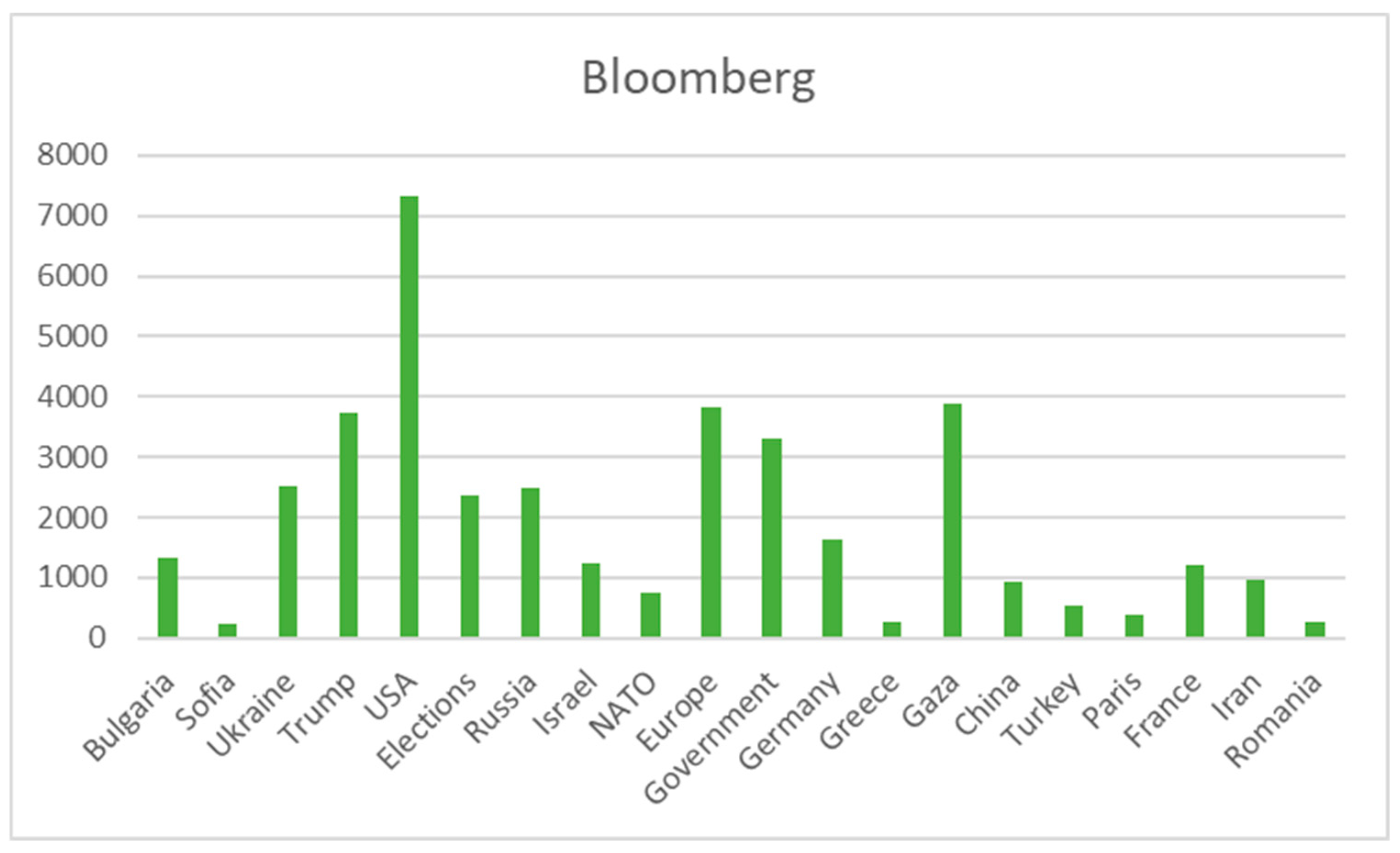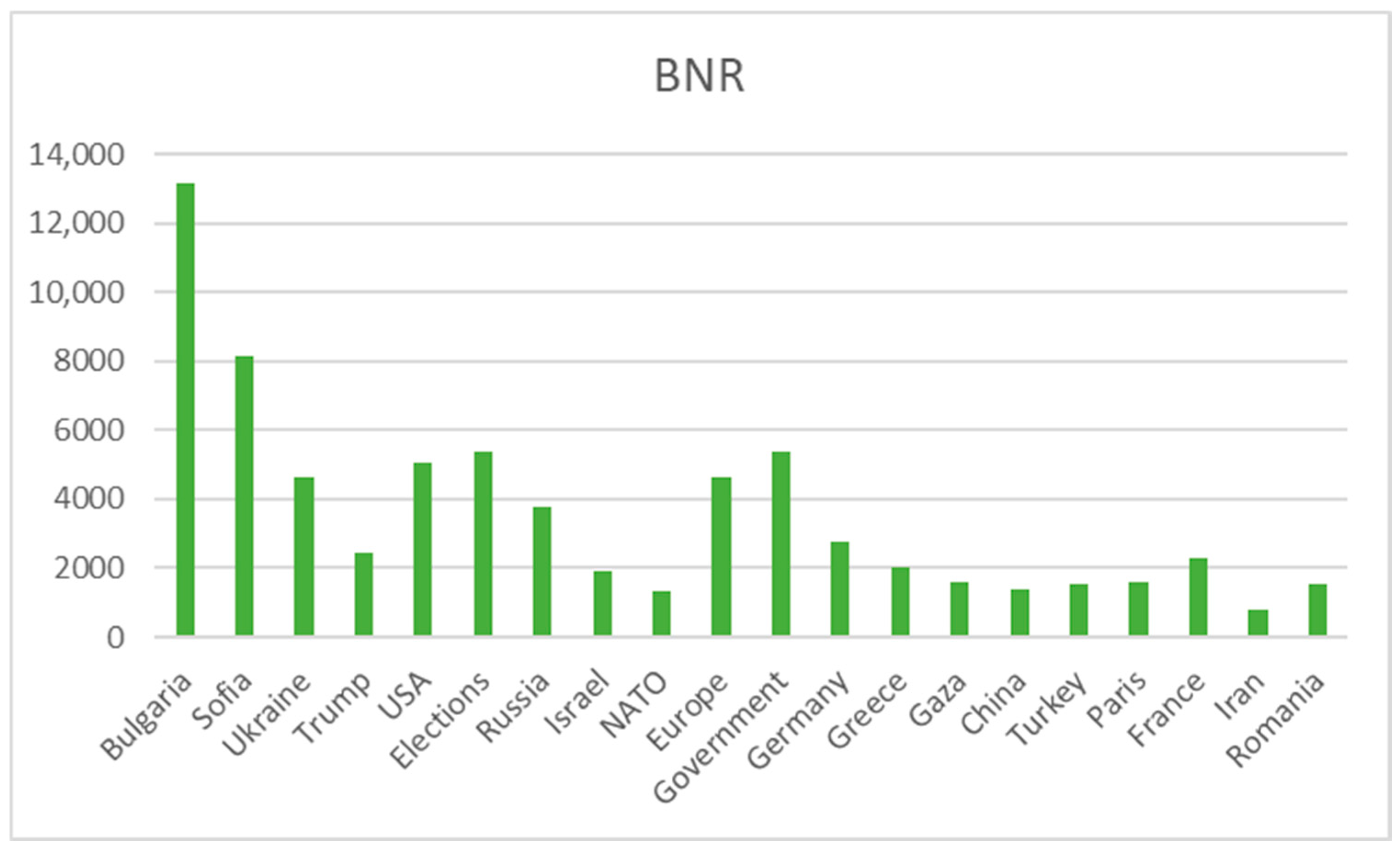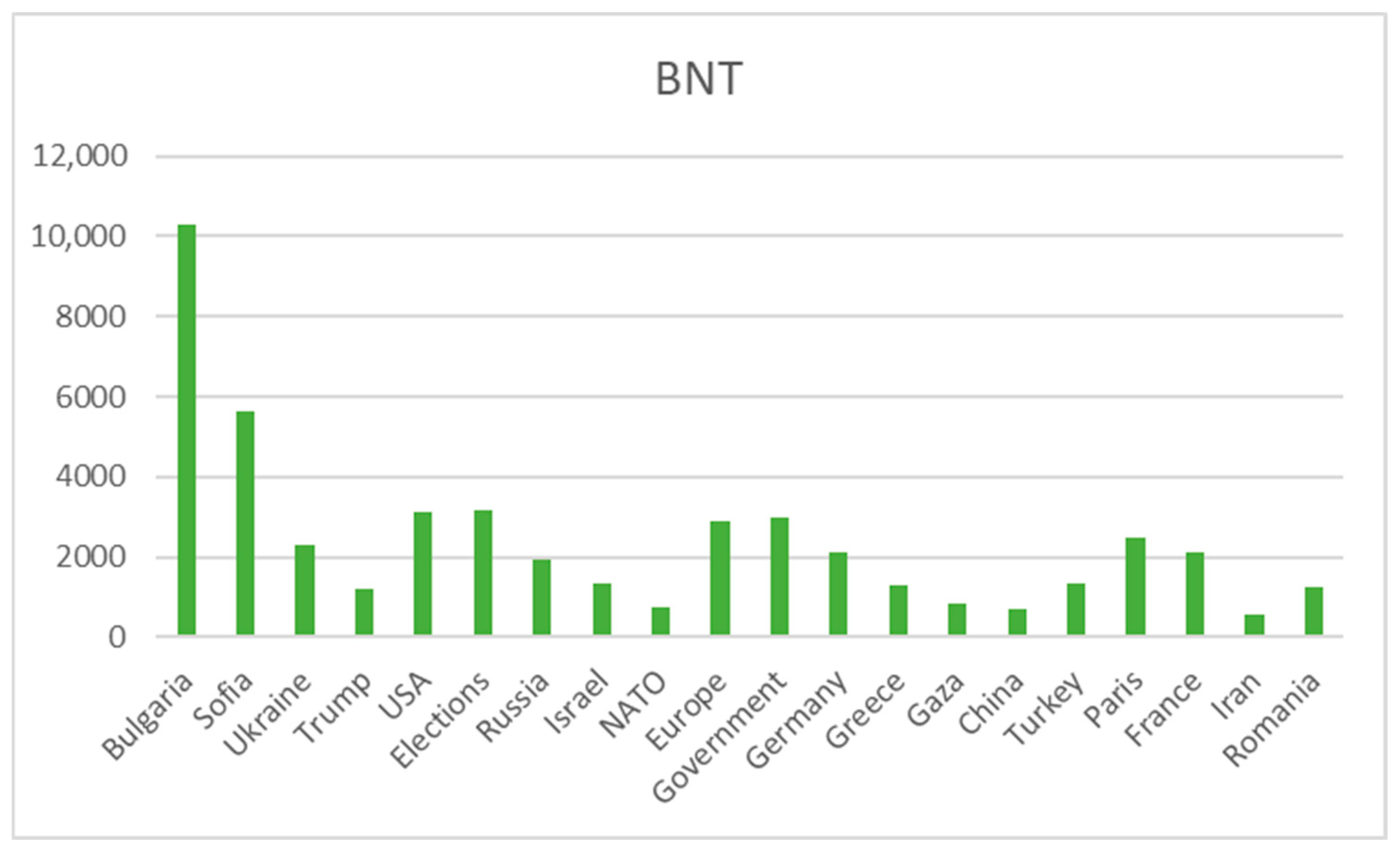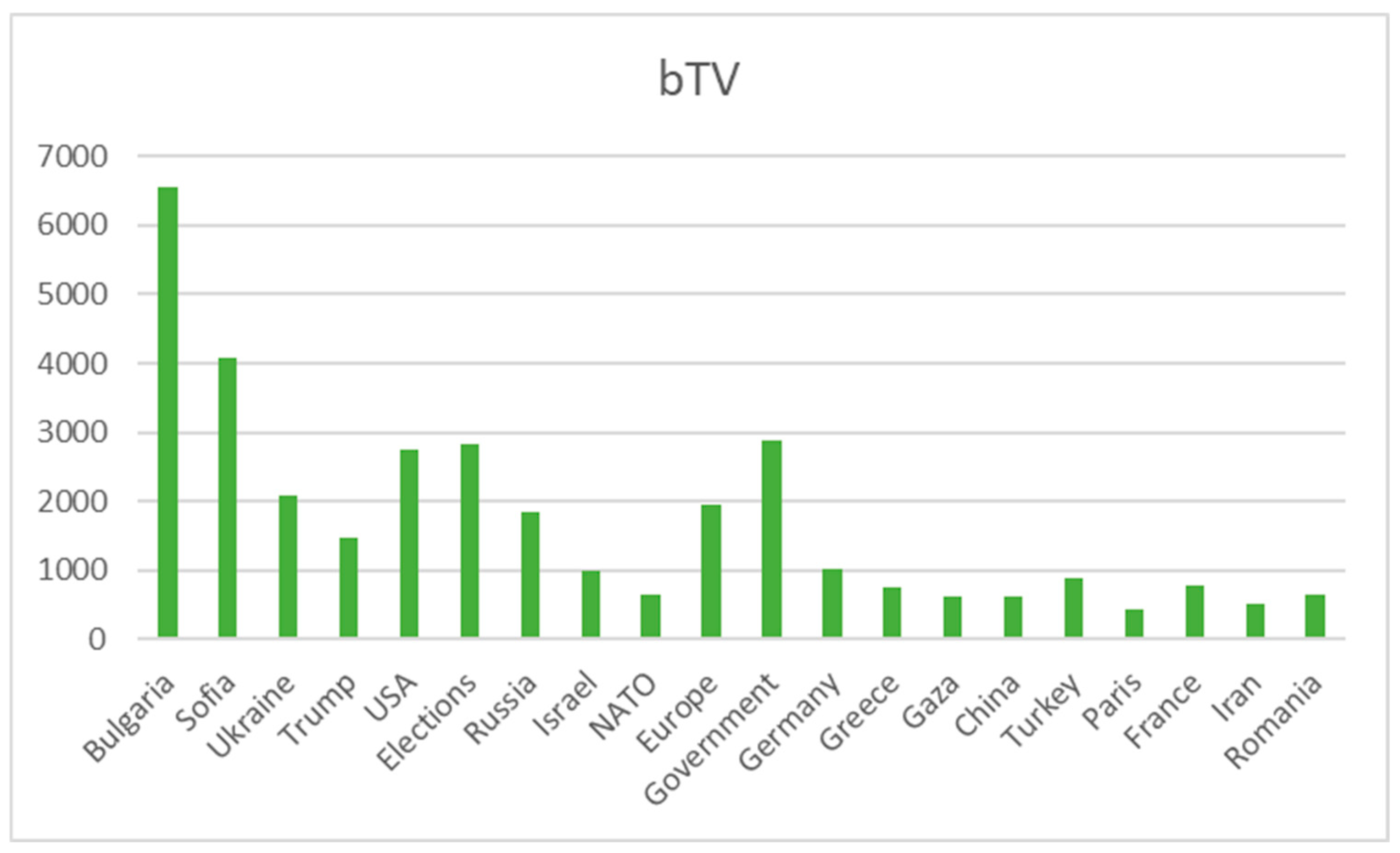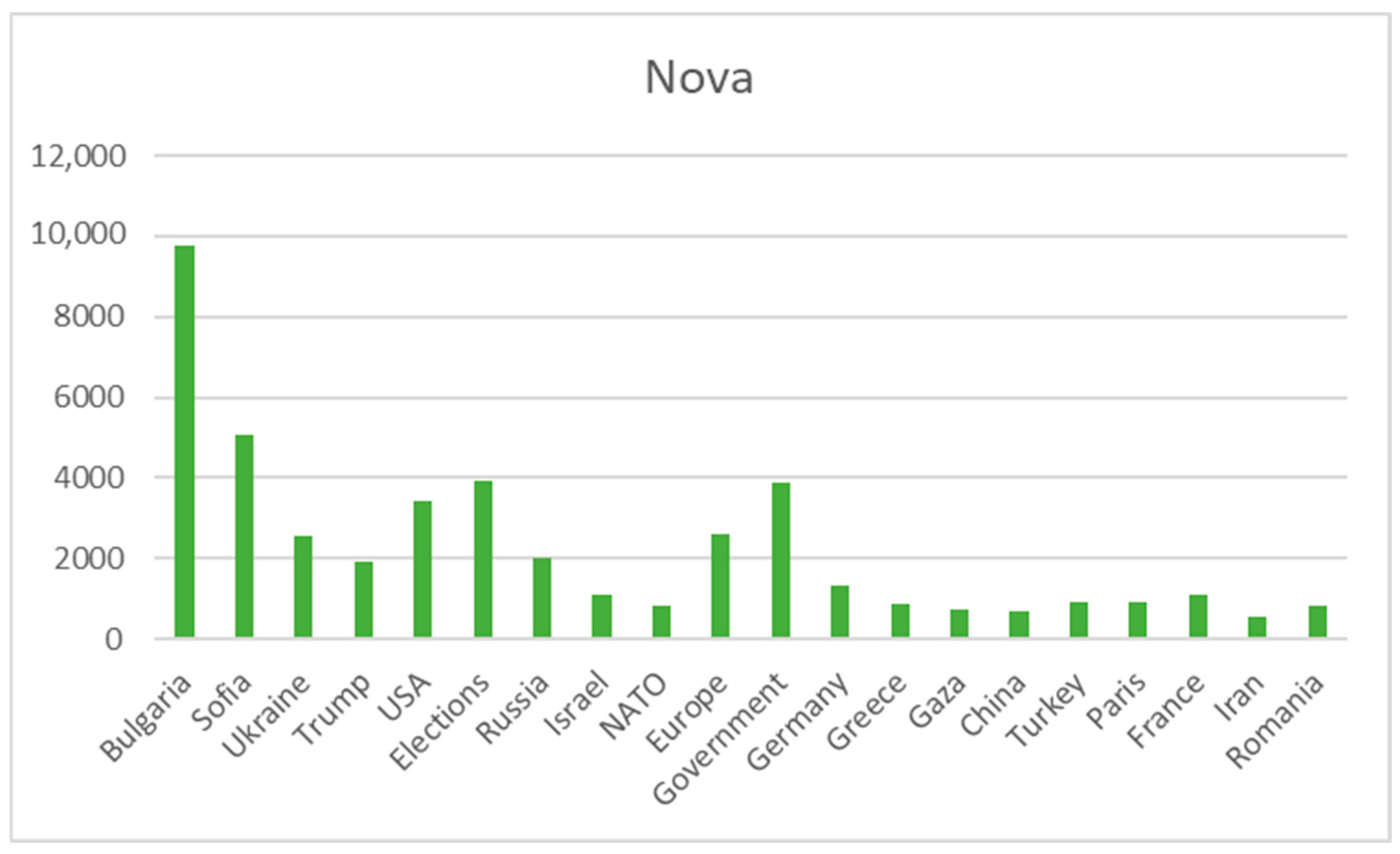2. Materials and Methods
To collect and process the dataset used in this study, a custom web scraping Java desktop application was developed. Although alternative approaches such as Gaussian-based kernels [
6] and Bayesian text classifiers [
4,
16] are available and have demonstrated strong performance in classification tasks, the current study employs a Java-based custom web scraping and lexical frequency analysis approach due to its effectiveness for large-scale structured data extraction and its alignment with the specific research objectives of this study, namely capturing comprehensive lexical dynamics across multiple news platforms. Our methodological approach aligns with recent computational frameworks that utilize narrative mapping techniques to systematically identify and analyze media framing patterns [
17]. The system combines JavaFX for user interface management and embedded browser functionality with jsoup for robust HTML parsing and content extraction. Web scraping has proven highly effective in various fields, including analyzing consumer sentiment in tourism [
15], gathering structured data for film rating analytics [
18], decentralizing and verifying news sources using blockchain technology [
19], and extracting key phrases from web content [
20]. The application targets the following eight major Bulgarian media websites: Bulgaria ON AIR, Bloomberg TV Bulgaria, BNR, BNT, bTV, DW (Bulgarian service), Eurocom, and Nova TV, which were selected for their broad audience reach and continuous digital publishing activity. The application employs the JavaFX components WebView and WebEngine to simulate a lightweight browser capable of loading both static and dynamically generated web content [
21]. The internal logic and interaction between the system’s components are illustrated in
Figure 1.
Upon launching, the application creates a stage and displays a scene containing a WebView, which loads the specified media URL. The associated WebEngine executes the page rendering and, where needed, runs JavaScript scripts to ensure that dynamically generated elements are fully accessible. Once the webpage is fully loaded, its HTML content is extracted. This raw HTML is then passed to the jsoup parser, which systematically analyzes and extracts key article components, such as the title, publication date, main body text, and page metadata [
22]. A key characteristic of the system is that it performs a full-text lexical analysis of every article during runtime. Rather than relying on a predefined set of keywords, the application extracts all words found in both the article title and body. For each word encountered, the system records whether it appears in the title, in the text, or in both. In addition, the structured output includes the publication date and the URL of each article. No full-text articles were stored after processing. Once the analytical extraction was complete, only the structured dataset—containing word occurrences and associated metadata—was retained. This design ensures efficient data handling and minimizes long-term storage requirements, while enabling the generation of statistically sound lexical datasets. This data model also ensures compliance with web usage guidelines. Duplicate detection was handled using unique text hashes, and only canonical articles were retained. In cases where parsing failed due to layout inconsistencies, error logs were maintained and problematic entries excluded from analysis. The final dataset includes only verified entries with valid URLs, ensuring consistent quality. Ethical compliance was ensured by scraping only publicly available content without bypassing paywalls or authentication. All targeted platforms were monitored to ensure adherence to their terms of service. Additionally, full article texts were not retained after analysis, limiting potential copyright or privacy concerns. The resulting structured dataset served as the foundation for determining the most frequently occurring words over the one-year period (April 2024–March 2025) and supported further analyses on temporal trends and editorial focus across media platforms. This approach aligns with contemporary practices in computational content analysis, where full-text data are used to extract structured insights at scale [
23]. The selection of JavaFX and jsoup for developing the custom web scraping application was guided by several key considerations. JavaFX provides a robust graphical user interface and efficient integration with Java-based backend components, allowing the seamless creation of desktop applications that support user-friendly operation and real-time monitoring of the scraping process. On the other hand, jsoup was chosen due to its ease of use, effective parsing of HTML content, and reliable extraction capabilities even with dynamically loaded content. Alternative scraping tools and languages such as Python-based Scrapy and Beautiful Soup were initially considered [
24,
25]. However, Python solutions, while widely adopted and powerful, generally require additional components to manage desktop integration and user interfaces effectively. Furthermore, Scrapy, despite its powerful automation features, often requires more complex initial configuration and has limitations in straightforward desktop application embedding. Consequently, the chosen Java-based approach provided an optimal balance between usability, integration, maintainability, and performance tailored to the specific research needs of systematically analyzing multiple online media platforms. To align with recent methodological best practices, we also considered the potential for temporal bias introduced by scraping cycles [
26]. While this study did not aim to perform sentiment analysis, future extensions could incorporate frameworks, where scraping and classification are integrated [
27].
The selected media platforms reflect a diversity of ownership structures, editorial profiles, and audience orientations. Bulgaria ON AIR is a national media outlet combining television broadcasting with an active online presence, covering both domestic affairs and international developments [
28]. Bloomberg TV Bulgaria is a business-focused platform affiliated with the global Bloomberg network, providing financial news, economic commentary, and global market insight [
29]. BNR (Bulgarian National Radio) is Bulgaria’s public radio broadcaster, offering comprehensive coverage of political, economic, and cultural developments, with an emphasis on public service content [
30]. BNT (Bulgarian National Television) serves as the country’s national public television channel, delivering wide-ranging domestic news and institutional reporting [
31]. bTV is a leading private television network in Bulgaria, offering mainstream news coverage with a blend of local and international focus [
32]. DW (Deutsche Welle, Bulgarian edition) is the Bulgarian-language service of Germany’s international broadcaster, with a strong emphasis on foreign policy, European affairs, and global analysis [
33]. Eurocom is a private Bulgarian television channel with an independent editorial stance, known for its political commentary and attention to domestic issues [
34]. Nova TV is a major commercial broadcaster in Bulgaria, offering dynamic coverage of current events, with a mix of national reporting and coverage of international developments [
35]. These sources were selected to ensure a representative overview of Bulgaria’s digital media environment, encompassing both public and private, national and international perspectives.
One notable methodological limitation of this study stems from the decision not to store the full-text articles after the initial processing. While this choice effectively addresses potential privacy and copyright concerns, it restricts deeper semantic or sentiment analyses, which would have required access to the complete original texts. To mitigate this constraint, the scraping tool was designed to store extensive metadata, including word-level occurrences in titles and texts, timestamps, and article URLs, thus providing a rich structured dataset. This approach ensures sufficient detail for robust lexical frequency analysis and temporal tracking while respecting ethical and legal considerations. However, future research aiming at more nuanced textual or sentimental analyses would benefit from storing complete or partially anonymized text data, provided that appropriate ethical and copyright clearances can be ensured. Another limitation of the analysis is the exclusion of multimedia content such as videos, images, or embedded social media posts, which increasingly constitute a substantial part of digital journalism and editorial framing. Although the sample covers eight prominent media platforms, it may not represent the entire Bulgarian digital media landscape, potentially omitting smaller, niche, or partisan outlets. Future work incorporating topic modeling, discourse analysis, and multimodal content could provide a more comprehensive picture.
3. Results
The selection of media sources included in this analysis was based on their significant influence, audience reach, and active digital presence within the Bulgarian media landscape. Specifically, the selected platforms are prominent media outlets with television and/or radio coverage, representing a mixture of public and private media, as well as local and international news providers. This approach ensures a diverse and comprehensive overview of online media content in Bulgaria. The analyzed dataset covers a period of one year, specifically from April 2024 to March 2025. This timeframe was chosen to provide an up-to-date and representative snapshot of contemporary media coverage, capturing seasonal trends, significant national and international events, and editorial dynamics across the examined platforms. The data collected from these sources are presented in the following tables and are graphically illustrated in corresponding figures to facilitate clear and insightful analysis.
Table 1 presents the total number of publications for each of the analyzed media platforms within the period from April 2024 to March 2025.
The data clearly illustrate considerable variations in the quantity of published content across the examined media platforms. The Bulgarian National Radio (BNR) recorded the highest total number of publications, amounting to 52,692, followed by Nova (44,867 publications), and the Bulgarian National Television (BNT) with 41,520 publications. These three media outlets evidently play leading roles in terms of news coverage and information dissemination within the country. Platforms such as Bulgaria ON AIR (34,213 publications) and Eurocom (32,358 publications) also demonstrate considerable activity, highlighting their significance within the Bulgarian digital media landscape. Other platforms like bTV (25,911 publications) and Bloomberg (13,842 publications) show moderate content activity. In stark contrast, Deutsche Welle (DW) published significantly fewer articles, only 2719. This disparity is likely due to DW’s specific editorial strategy focusing on selected international and socially significant topics, as opposed to local Bulgarian platforms, which tend to provide more frequent daily news coverage. These initial findings offer an essential starting point for subsequent analyses, helping to identify the dominant information sources in Bulgaria’s digital media ecosystem and enabling the formulation of hypotheses regarding editorial policies and target audiences of the various media platforms.
Table 2 presents the 20 most frequently occurring words in publication titles, along with their occurrences in the main body of the publication texts, during the analyzed period (April 2024–March 2025).
Figure 2 provides a graphical representation of the data shown in
Table 2 in the context of the top 20 most frequent words in publication titles.
The analysis of the most frequently used words in publication titles highlights key thematic focuses of the studied media platforms. The prominence of geographic references such as “Bulgaria” (9008 occurrences) and “Sofia” (7776 occurrences) underlines a strong emphasis on domestic news and local events. Frequent mentions of countries and geopolitical terms including “Ukraine”, “USA”, “Russia”, “Israel”, “Germany”, “Greece”, “China”, “Turkey”, “France”, “Iran”, and “Romania” reflect significant editorial attention to international affairs, geopolitical tensions, and diplomatic relations. The presence of “Trump” (6374 occurrences) and thematic words such as “Elections” and “Government” indicate an ongoing focus on politics and governance issues. The occurrence of “Paris” (1662 occurrences) is likely driven by heightened media attention around the upcoming 2024 Summer Olympic Games hosted in the French capital.
Figure 3 provides a graphical representation of the data shown in
Table 2 in the context of the occurrences of the top 20 title words in publication texts.
The frequency of these title words in publication texts further validates their thematic significance within media content. Words such as “Bulgaria” (55,816 occurrences) and “Sofia” (30,777 occurrences) maintain their prominence, underscoring the continuous coverage of domestic topics throughout the articles. Terms like “Government” (26,030), “Elections” (24,628), and “USA” (29,274) highlight in-depth discussions related to political and governance issues, both domestically and internationally. The extensive mentions of geopolitical entities such as “Ukraine”, “Russia”, and “Europe” demonstrate consistent editorial interest in global affairs. Lower but significant frequencies of terms such as “Paris” (7104 occurrences) further reflect sustained interest related to internationally relevant events, notably the Paris 2024 Olympics, generating deeper textual coverage beyond headlines. It is noteworthy that the ranking of words based on their frequency in publication titles does not completely align with their frequency within the publication texts. Such discrepancies suggest differences in editorial strategies between selecting attention-grabbing headlines and delivering detailed content within the articles. For instance, certain terms like “Trump”, “NATO”, and “Israel” have relatively high prominence in titles compared to their frequency in article texts, likely due to their newsworthiness and capacity to attract readers’ attention. Conversely, words such as “Government”, “Europe”, and “Bulgaria”, which have higher occurrences within texts, indicate deeper thematic coverage beyond mere headlines. This observation underscores the distinct roles played by titles (aiming to capture reader interest quickly) and article bodies (intended to provide comprehensive and detailed information).
To achieve a deeper understanding of editorial priorities and thematic preferences among individual media platforms, we conducted a detailed analysis of how frequently the top 20 identified keywords appear in each platform’s publications. This analysis reveals distinct editorial strategies, varying focuses on domestic and international topics, and potential audience targeting differences across media outlets.
Table 3 presents the distribution of the top 20 words in publications of Bulgaria ON AIR from April 2024 to March 2025.
The keyword distribution in the content of Bulgaria ON AIR indicates a strong editorial interest in both domestic and international themes, with a clear balance between local relevance and global reporting. The dominant presence of “Bulgaria” (7866) and “Sofia” (4026) confirms consistent attention to national and urban issues, likely reflecting daily political, social, and infrastructural developments. Additionally, “Government” (2760) and “Elections” (2790) highlight the channel’s sustained focus on political processes and institutional coverage. Among international topics, terms like “USA” (2896), “Ukraine” (2666), “Russia” (2290), and “Europe” (2089) appear frequently, reflecting global political tensions and regional diplomacy, likely driven by ongoing conflicts and EU affairs. This suggests a relatively even distribution of coverage between Western and Eastern geopolitical interests. Notably, words associated with Middle Eastern conflicts—such as “Israel”, “Gaza”, “Iran”, and “Turkey”—also maintain a significant presence, pointing to a comprehensive international news agenda. Coverage of “Paris” (670) and “France” (851) may be related to high-profile global events like the 2024 Olympics or EU developments. In summary, Bulgaria ON AIR demonstrates a content strategy that intertwines domestic political reporting with timely international developments, positioning itself as a news source with both local grounding and global awareness.
Table 4 presents the distribution of the top 20 words in publications of Bloomberg from April 2024 to March 2025.
The data for Bloomberg TV Bulgaria reaffirm the outlet’s international and policy-oriented focus, with minimal emphasis on local content. Terms like “USA” (7320), “Gaza” (3891), “Trump” (3742), “Europe” (3813), and “Government” (3313) are among the most prominent, reflecting deep editorial engagement with global political developments, international conflict, and leadership dynamics. Although “Bulgaria” (1341) and “Sofia” (247) are present, their relatively low frequencies suggest limited coverage of national or local topics, aligning with Bloomberg’s global positioning and target audience. This contrast is especially noticeable when compared to public broadcasters such as BNR or BNT. The strong presence of “Russia”, “Ukraine”, “China”, “Germany”, and “France” reflects focused attention on major global actors and regions relevant to economic and geopolitical analysis. The especially high number of mentions of “Gaza” (even surpassing “Trump”) indicates extensive coverage of Middle Eastern conflicts, likely viewed through the lenses of global stability, humanitarian impact, and international policy response. Topics related to elections (2368) and governance (3313) further emphasize the outlet’s interest in institutional processes, democratic systems, and global leadership transitions, which are core themes for Bloomberg’s economic–political reporting model. In summary, Bloomberg TV Bulgaria stands out for its strongly international, policy-centric editorial strategy, with limited domestic coverage but deep engagement with global developments that affect markets, security, and international governance.
Table 5 presents the distribution of the top 20 words in publications of BNR from April 2024 to March 2025.
The data for BNR confirm its profile as a public service broadcaster with a strong focus on national and institutional topics. The most frequently occurring words—“Bulgaria” (13,176), “Sofia” (8149), “Elections” (5400), and “Government” (5389)—reflect the outlet’s consistent commitment to informing the public about domestic affairs, governance, and political processes. The frequency of “Ukraine” (4625), “Russia” (3798), “USA” (5071), and “Europe” (4632) indicates substantial attention to global developments, especially those with geopolitical significance for Bulgaria and the European Union. This supports BNR’s role not only as a national broadcaster, but also as a gateway to international information for the Bulgarian audience. Mentions of “NATO” (1356), “Israel” (1941), and “Gaza” (1573) reflect coverage of international security, military alliances, and conflicts, which are themes that are both timely and relevant in the current global context. At the same time, regional countries such as Greece, Romania, and Turkey appear with relatively high frequency, confirming a regional orientation in addition to global and national reporting. The coverage of “Trump” (2467), “France” (2315), and “Germany” (2751) points to consistent attention to the political dynamics in key Western countries, likely in relation to diplomacy, European affairs, or global leadership shifts. In conclusion, BNR maintains a well-balanced editorial strategy, with a strong core of national reporting complemented by robust international coverage. The data highlight BNR’s role as a comprehensive and reliable source of both domestic and global news for Bulgarian audiences.
Table 6 presents the distribution of the top 20 words in publications of BNT from April 2024 to March 2025.
The lexical distribution for BNT, Bulgaria’s national public television broadcaster, demonstrates a balanced editorial approach, combining extensive national coverage with regular attention to international developments. The high frequency of domestic terms such as “Bulgaria” (10,294) and “Sofia” (5628) reflects the outlet’s public service mission to inform citizens about national and municipal issues. Similarly, the substantial use of “Elections” (3174) and “Government” (2992) confirms BNT’s role in reporting on institutional processes, democratic governance, and policy matters. While the international terms appear in lower absolute numbers compared to some other platforms, they still indicate solid global engagement. The presence of “USA” (3109), “Europe” (2884), “Ukraine” (2325), and “Russia” (1927) shows that BNT maintains consistent coverage of global geopolitical developments, particularly those affecting the region and Bulgaria’s international position. Mentions of “Germany” (2111), “France” (2128), and especially “Paris” (2500) suggest coverage of European Union affairs and major global events, likely including the 2024 Summer Olympics in Paris, which could explain the notable prominence of the city name. Terms such as “Israel”, “Gaza”, and “Iran” reflect coverage of Middle Eastern conflicts, albeit at a more moderate level than in international or business-focused outlets. The regional perspective is reinforced through frequent references to Greece, Turkey, and Romania. Overall, BNT’s content profile aligns with its role as a national broadcaster, informing the public on local governance and national politics, while maintaining a clear, though proportionally smaller, window to the international stage.
Table 7 presents the distribution of the top 20 words in publications of bTV from April 2024 to March 2025.
The content distribution for bTV, one of Bulgaria’s largest private national broadcasters, reveals a balanced editorial profile with a slightly stronger domestic orientation complemented by solid international reporting. High frequencies of “Bulgaria” (6542) and “Sofia” (4069) confirm consistent coverage of national and local events. The prominence of “Government” (2869) and “Elections” (2839) indicates a strong focus on political processes, public institutions, and electoral dynamics, which are key themes in national reporting. Although the frequencies for international terms are not as high as in internationally oriented platforms like Bloomberg or DW, bTV maintains a well-rounded foreign affairs section. Terms such as “USA” (2761), “Ukraine” (2093), “Russia” (1836), and “Europe” (1947) demonstrate attention to major global developments, particularly those affecting Bulgaria’s geopolitical context. Coverage of Middle Eastern issues is present but relatively modest, with “Israel”, “Gaza”, “Iran”, and “NATO” each appearing in under 1000 publications. This suggests that international conflict is covered selectively, likely based on event salience or relevance to domestic discourse. Regional focus is visible through mentions of Greece (764), Turkey (878), and Romania (654), suggesting attention to Bulgaria’s neighboring countries and EU partners. In conclusion, bTV exhibits a dual editorial focus, combining consistent reporting on national politics and institutions with contextual international coverage, without showing the extreme thematic skew typical of either public broadcasters or international news agencies.
Table 8 presents the distribution of the top 20 words in publications of DW from April 2024 to March 2025.
The data for DW, a Bulgarian service, as an international broadcaster, reflect a clearly global editorial focus, consistent with Deutsche Welle’s mission to present international perspectives to regional audiences. Domestic keywords such as “Bulgaria” (600) and “Sofia” (187) appear with relatively low frequency, confirming that DW does not prioritize local news reporting. Instead, the editorial emphasis is on broader political, global, and democratic developments. Terms such as “Government” (978), “USA” (946), “Ukraine” (827), “Russia” (835), and “Germany” (815) are among the most frequent, suggesting sustained coverage of international political relations, war and conflict, governance, and EU affairs. Germany’s presence, not surprisingly, is notable and likely influenced by DW’s country of origin and its lens on EU leadership and diplomacy. “Europe” (722) and “Elections” (674) reinforce DW’s attention to institutional and political processes across the continent. NATO, Israel, Gaza, and China also appear regularly, indicating the coverage of geopolitical flashpoints and international security. Compared to other platforms, DW places less emphasis on regional neighbors like Greece, Romania, and Turkey, likely due to its global orientation rather than Balkan-centric focus. In conclusion, DW’s Bulgarian service demonstrates a predominantly international content strategy, reporting on major geopolitical and governance topics while providing minimal coverage of Bulgarian domestic affairs—aligning fully with its role as a global public broadcaster.
Table 9 presents the distribution of the top 20 words in publications of Eurocom from April 2024 to March 2025.
The lexical profile of Eurocom, a private Bulgarian media outlet with a distinct editorial voice, shows a strong engagement with national political content, paired with considerable attention to international developments. The high number of references to “Bulgaria” (6251), “Sofia” (3417), “Government” (3865), and “Elections” (3482) clearly reflects a dominant focus on domestic politics, governance, and civic affairs. This positions Eurocom as an outlet heavily invested in political commentary and national discourse. However, Eurocom also dedicates substantial coverage to international affairs, with terms like “USA” (3736), “Ukraine” (3528), “Russia” (2990), and “Trump” (2446) appearing at high frequencies. This mix suggests an editorial strategy that combines internal political analysis with global context, particularly the international dimensions of security, diplomacy, and foreign influence. The presence of “NATO” (1027) and “Europe” (2206) reinforces Eurocom’s attention to Bulgaria’s place within regional and alliance structures, while Middle Eastern topics like “Israel”, “Gaza”, and “Iran” are present but not dominant. Mentions of “China” (1041) and “Germany” (1013) reflect interest in key global powers, while references to neighboring countries like “Turkey”, “Greece”, and “Romania” support a well-rounded editorial scope that includes regional relevance. In summary, Eurocom demonstrates a dual editorial profile that is deeply focused on domestic political life, while simultaneously maintaining a meaningful presence in international and geopolitical reporting. This combination positions the outlet as both nationally engaged and globally aware.
Table 10 presents the distribution of the top 20 words in publications of Nova from April 2024 to March 2025.
The lexical profile of Nova TV, one of Bulgaria’s major commercial broadcasters, reflects a content strategy that strongly integrates national political focus with timely international coverage. Terms like “Bulgaria” (9746), “Sofia” (5054), “Government” (3864), and “Elections” (3901) show that Nova maintains high engagement with domestic politics and governance, reflecting the editorial weight placed on informing viewers about internal developments and institutional processes. Internationally, Nova provides moderate but consistent coverage of global topics. Frequent mentions of “USA” (3435), “Ukraine” (2544), “Russia” (2015), and “Europe” (2587) suggest a broad awareness of key geopolitical developments, especially those with regional and security implications. Nova also demonstrates engagement with event-driven topics, such as “Trump” (1925) and “Paris” (906), with the latter likely driven by the 2024 Summer Olympics. Similarly, “France” (1113) and “Germany” (1319) show up with relatively high frequency, reflecting the importance of EU-centric coverage. Mentions of “Israel”, “Gaza”, “Iran”, and “NATO” confirm that Nova addresses international conflicts and alliances, though not with the intensity seen in more globally focused outlets like Bloomberg or DW. The presence of regional neighbors—“Greece”, “Turkey”, and “Romania”—further supports Nova’s commitment to reporting with both national and regional relevance. In conclusion, Nova TV offers a broad editorial mix, balancing domestic political reporting with the responsive coverage of global and regional developments. Its content reflects a mainstream media profile that is tailored to a general audience with interest in both local and international affairs.
The results obtained through the quantitative and lexical analysis of web publications from eight major Bulgarian media platforms over the period April 2024–March 2025 allow for several key experimental conclusions that highlight both overarching patterns and distinctive editorial strategies. The analysis of publication volume showed significant variation among platforms, with BNR, Nova, and BNT emerging as the most prolific sources of digital content. The examination of the most frequently used words in titles and full texts revealed a consistent editorial focus on both domestic and international topics. High-frequency terms such as “Bulgaria”, “Sofia”, and “Government” underscore the media’s engagement with national affairs, while terms like “USA”, “Ukraine”, “Russia”, and “Europe” reflect the salience of global geopolitical developments in Bulgarian media discourse. Comparative analysis between word usage in titles and in article bodies revealed editorial strategies designed to capture audience attention. Certain words, including “Trump” and “NATO”, appeared more frequently in titles than in article content, likely chosen for their attention-grabbing quality, a pattern consistent with digital-era editorial practices aimed at maximizing clicks and shares. Additionally, the frequent appearance of the terms “Trump”, “USA”, and “NATO” reflects not only global political relevance but also editorial decisions about what constitutes news value across platforms. Their presence suggests a strong interest in international power dynamics and security alliances, particularly in the context of war, elections, and diplomatic shifts. This may reflect editorial alignment with geopolitical concerns or reliance on international news agencies. For instance, the elevated frequency of “Trump” corresponds to intensified media attention surrounding the United States presidential primaries, illustrating how global political events shape the editorial agenda even in national media. The disparity between term frequency in titles versus article bodies highlights potential framing strategies. In contrast, words such as “Government” and “Bulgaria” were more dominant in the texts themselves, suggesting that these topics receive more substantive treatment within the body of the articles. Other terms, such as “Paris”, spiked in connection with specific international occasions like the 2024 Summer Olympics. Finally, the distribution of keywords across individual media platforms demonstrated clear editorial distinctions. Public service broadcasters such as BNR and BNT exhibited a strong focus on domestic issues and political coverage. In contrast, internationally oriented media such as Bloomberg, DW, and Bulgaria ON AIR emphasized global political and economic developments. Private national outlets including bTV, Nova, and Eurocom adopted a more balanced approach, combining consistent local reporting with selective but substantial international coverage.
To better understand the editorial dynamics across different types of media, a comparative overview of editorial tendencies among the eight analyzed platforms is presented in
Table 11.
The comparative analysis across the eight media platforms reveals distinct editorial patterns shaped by ownership structure, audience targeting, and institutional role. Public broadcasters such as BNR and BNT consistently emphasize national governance topics, reinforcing their traditional mandate for public service journalism. In contrast, private commercial outlets like Nova and bTV exhibit a more balanced mix of national and international topics, often reflecting market-driven editorial choices. International platforms such as DW and Bloomberg focus predominantly on foreign affairs, particularly economic and political developments in Europe and the United States. Hybrid platforms like Eurocom demonstrate higher levels of political commentary and domestically oriented narratives. These variations illustrate the complex interplay between media ownership, editorial policy, and the evolving digital news ecosystem in Bulgaria.

